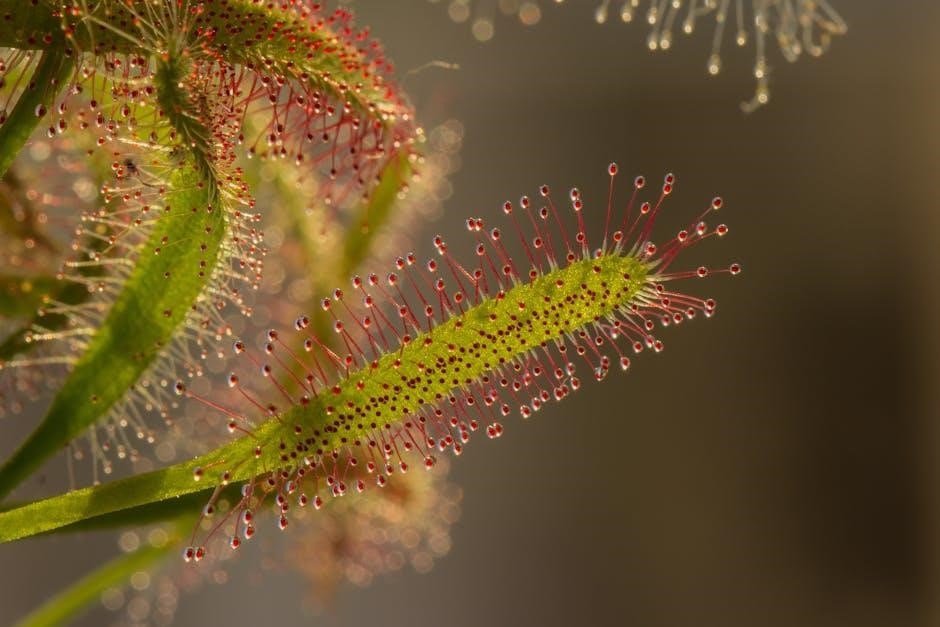study guide for photosynthesis
This guide provides a comprehensive overview of photosynthesis, covering its essential processes, key components, and practical applications. It helps students master the light-dependent and light-independent reactions, chlorophyll’s role, and how environmental factors influence photosynthesis efficiency. Perfect for exam preparation or deeper understanding of this vital biological process.
Photosynthesis is a vital biological process where plants, algae, and some bacteria convert sunlight, water, and carbon dioxide into glucose and oxygen. This process sustains life on Earth by providing energy and organic compounds for food chains. It occurs in chloroplasts and involves light-dependent and light-independent reactions, essential for ecosystem balance and oxygen production.
Overview of Photosynthesis
Photosynthesis is a complex biochemical process where plants, algae, and certain bacteria convert sunlight, carbon dioxide, and water into glucose and oxygen. This process occurs in chloroplasts and is divided into two main stages: light-dependent reactions and the Calvin Cycle. In the light-dependent reactions, light energy is absorbed by pigments like chlorophyll, leading to the production of ATP and NADPH. The Calvin Cycle uses these energy-rich molecules to fix carbon dioxide into glucose. Photosynthesis is fundamental for life, providing the oxygen we breathe and forming the base of food chains. Its efficiency depends on factors like light intensity, temperature, and CO2 concentration.
Importance of Photosynthesis
Photosynthesis is vital for life on Earth, as it provides oxygen and forms the base of food chains. It powers the biosphere by converting sunlight into chemical energy, supporting plant growth and, indirectly, all heterotrophic organisms. This process regulates Earth’s climate by absorbing CO2, a key greenhouse gas, and releasing oxygen, essential for respiration. Photosynthesis also sustains ecosystems, enabling energy storage in biomass, which fuels decomposition and nutrient cycling. Its significance extends to agriculture, forestry, and global food security, as crop yields depend on photosynthetic efficiency. Understanding photosynthesis is crucial for addressing climate change and improving agricultural practices to meet growing food demands.
Brief History of Photosynthesis Research
The study of photosynthesis dates back to the 18th century when scientists like Jan Ingenhousz discovered that light is essential for the process. In the early 20th century, the Calvin Cycle was identified, detailing how CO2 is fixed into sugars. Later, the role of chlorophyll and photosystems in capturing light energy was elucidated. Modern research continues to explore the molecular mechanisms, such as the conversion of light energy into ATP and NADPH, and the adaptation of photosynthesis in different environments. Understanding its history provides insights into the evolution of this critical biological process and its significance in sustaining life on Earth.

The Process of Photosynthesis
Photosynthesis is a biological process where plants, algae, and some bacteria convert light energy into chemical energy, producing glucose and oxygen from water and carbon dioxide using sunlight.
Light-Dependent Reactions
The light-dependent reactions occur in the thylakoid membranes of chloroplasts and require direct sunlight. Chlorophyll and other pigments absorb light energy, exciting electrons that are transferred through a series of proteins. This electron flow drives the production of ATP and NADPH, essential for the Calvin Cycle. Water molecules are split in the process, releasing oxygen as a byproduct. The energy from sunlight is converted into chemical energy stored in ATP and NADPH, which are then used to power the light-independent reactions. These reactions are critical for initiating photosynthesis and ensuring the subsequent steps can occur efficiently.
Light-Independent Reactions (Calvin Cycle)
The Calvin Cycle, also known as the light-independent reactions, takes place in the stroma of the chloroplast. It uses the ATP and NADPH produced in the light-dependent reactions to fix carbon dioxide into glucose. The cycle begins with the fixation of CO2 by the enzyme RuBisCO, which attaches CO2 to RuBP, forming a 6-carbon compound. This compound breaks down into two 3-carbon molecules (PGA), which are reduced using ATP and NADPH to form glyceraldehyde 3-phosphate (G3P). Some G3P molecules are used to produce glucose, while others regenerate RuBP to continue the cycle. This process is essential for producing organic molecules that sustain life on Earth.
Key Differences Between Light and Dark Reactions
The light-dependent reactions and light-independent reactions (Calvin Cycle) differ in location, requirements, and products. Light reactions occur in the thylakoid membranes, require direct light, and produce ATP and NADPH. Dark reactions take place in the stroma, do not require light, and use ATP and NADPH to fix CO2 into glucose. Light reactions are cyclic, while dark reactions are a cycle (Calvin Cycle). Light reactions are faster and rely on water splitting, whereas dark reactions are slower and depend on CO2 fixation. These differences highlight how light and dark reactions complement each other to achieve photosynthesis, with light reactions providing energy and dark reactions using it to produce organic molecules.

Light-Dependent Reactions
The light-dependent reactions occur in thylakoid membranes, absorbing light energy via chlorophyll and other pigments. Light energy is converted into ATP and NADPH, releasing oxygen as a byproduct;
Absorption of Light Energy
Light energy absorption occurs in the thylakoid membranes of chloroplasts, where pigments like chlorophyll a and b, and carotenoids capture sunlight. Chlorophyll a absorbs blue and red light most efficiently but reflects green light, giving plants their color. These pigments transfer absorbed energy to a special molecule, initiating the electron transport chain. This process is crucial for converting light energy into chemical energy, producing ATP and NADPH for the Calvin Cycle. Efficient light absorption ensures energy availability for photosynthesis, highlighting the importance of pigment diversity and thylakoid structure in optimizing this process.
Structure and Function of Thylakoids
Thylakoids are membrane-bound structures within chloroplasts, arranged in stacks called grana. Their membranes contain pigments like chlorophyll and are the site of light-dependent reactions. The thylakoid lumen stores water, which is split during photolysis, releasing oxygen. The surface area of thylakoids is increased by their folded structure, enhancing light energy absorption. They are crucial for converting light energy into ATP and NADPH, essential for the Calvin Cycle. The thylakoid membrane also houses photosystems II and I, which drive electron transport and proton gradients. This structure optimizes light-dependent reactions, ensuring efficient energy conversion for photosynthesis.
Role of Chlorophyll and Other Pigments
Chlorophyll and other pigments are vital for absorbing light energy, a critical step in photosynthesis. Chlorophyll a and b primarily absorb blue and red light, reflecting green, which is why plants appear green. Accessory pigments like carotenoids (e.g., carotene and xanthophylls) capture light in the blue-violet spectrum and protect the plant from photodamage. These pigments are embedded in the thylakoid membranes, forming pigment-protein complexes that facilitate energy transfer. Chlorophyll plays a central role in initiating the light-dependent reactions by transferring electrons, while other pigments broaden the range of light absorbed. Together, they optimize energy capture, enabling efficient photosynthesis across varying light conditions.
Production of ATP and NADPH
The light-dependent reactions produce ATP and NADPH, essential energy-rich molecules for the Calvin Cycle. Light energy drives the splitting of water in PSII, releasing electrons that flow through a transport chain in the thylakoid membrane. This process generates a proton gradient, which ATP synthase uses to produce ATP. Simultaneously, PSI captures light energy, further energizing electrons that combine with NADP+ to form NADPH. These molecules store chemical energy derived from light, which is then used in the light-independent reactions to fix carbon dioxide into glucose. ATP and NADPH are critical for powering the carbon fixation and reduction processes in the Calvin Cycle.
Role of Photosystems (PSII and PSI)
Photosystems II (PSII) and I (PSI) are critical pigment-protein complexes in the thylakoid membrane, playing distinct roles in the light-dependent reactions. PSII absorbs light energy, initiating the electron transport chain by oxidizing water, releasing oxygen, and generating ATP. PSI, on the other hand, captures light energy to further energize electrons, producing NADPH. Together, these photosystems ensure the efficient conversion of light energy into chemical energy, enabling the production of ATP and NADPH, which are essential for the Calvin Cycle. Their coordinated function is vital for the overall process of photosynthesis, highlighting the interconnected roles of light absorption and energy transfer.

Calvin Cycle (Light-Independent Reactions)
The Calvin Cycle is a light-independent process occurring in the chloroplast stroma, fixing carbon dioxide into glucose using ATP and NADPH from the light reactions. It’s essential for producing organic molecules.
Carbon Dioxide Fixation
Carbon dioxide fixation is the first step in the Calvin Cycle, where CO₂ is incorporated into a 5-carbon molecule called ribulose-1,5-bisphosphate (RuBP). This reaction is catalyzed by the enzyme RuBisCO, producing two molecules of 3-phosphoglycerate (PGA). PGA is then reduced to form glyceraldehyde-3-phosphate (G3P) using ATP and NADPH produced in the light-dependent reactions. The G3P molecules are used to synthesize glucose and other organic compounds. Meanwhile, the RuBP molecule is regenerated to continue the cycle. This process is critical for converting inorganic carbon into organic molecules, making it a cornerstone of photosynthesis.
Role of RuBP in Carbon Fixation
RuBP (ribulose-1,5-bisphosphate) is a 5-carbon molecule essential in the Calvin Cycle for carbon fixation. It binds to CO₂, catalyzed by RuBisCO, forming two 3-carbon molecules of 3-phosphoglycerate (PGA). This step is fundamental for converting atmospheric CO₂ into organic compounds. RuBP is regenerated through a series of reactions, ensuring the cycle’s continuity. Its role is critical as it directly facilitates the incorporation of carbon dioxide into the biosphere, making it indispensable for photosynthesis. This process highlights the interplay between light-dependent reactions, which supply ATP and NADPH, and the Calvin Cycle, emphasizing RuBP’s central role in sustaining life on Earth.
Regeneration of RuBP
Regeneration of RuBP is a critical step in the Calvin Cycle, ensuring the cycle’s continuity. After RuBP binds with CO₂ to form 3-phosphoglycerate (PGA), it must be regenerated. This process involves a series of enzyme-driven reactions that convert PGA back into RuBP. ATP from the light-dependent reactions provides the energy needed for this regeneration. The cycle ensures that RuBP is available to bind with CO₂ again, maintaining the flow of carbon fixation. This step is essential for sustaining the Calvin Cycle and enabling plants to continuously produce glucose. Without RuBP regeneration, the cycle would halt, making this step vital for photosynthesis and life on Earth.
Key Enzymes in the Calvin Cycle
The Calvin Cycle relies on several key enzymes to facilitate its reactions. RuBisCO (Ribulose-1,5-Bisphosphate Carboxylase/Oxygenase) is the most critical enzyme, catalyzing the fixation of CO₂ into RuBP to form PGA. Another essential enzyme is phosphoribulokinase, which converts ribulose-5-phosphate into RuBP, enabling the cycle to continue. ATP synthase plays a role in generating ATP during the light-dependent reactions, which is later used in the Calvin Cycle. These enzymes work in harmony to ensure efficient carbon fixation, glucose synthesis, and RuBP regeneration. Their activity is finely regulated by light, ATP levels, and pH to optimize photosynthesis under varying conditions. Without these enzymes, the Calvin Cycle would not function, making them indispensable for life on Earth.
C3 vs. C4 Pathways
The C3 and C4 pathways are two distinct mechanisms plants use to fix carbon dioxide during photosynthesis. In C3 plants, CO₂ is fixed directly into a 3-carbon molecule (RuBP) via RuBisCO, leading to the production of two 3-carbon molecules (PGA). This process is efficient in cool, moist environments but can be limited by photorespiration when oxygen levels are high. In contrast, C4 plants first fix CO₂ into a 4-carbon molecule before transferring it to the Calvin Cycle, reducing photorespiration and improving efficiency in hot, dry conditions. Both pathways require ATP but differ in their anatomical and biochemical adaptations. Understanding these pathways is crucial for improving crop yields under varying environmental conditions.

Factors Affecting Photosynthesis
Light intensity, carbon dioxide concentration, temperature, and water availability significantly influence photosynthesis. Optimal levels of these factors enhance photosynthetic efficiency, while extremes can limit or inhibit the process.
Light Intensity
Light intensity is a critical factor in photosynthesis, directly influencing the rate of light-dependent reactions. Increased light intensity enhances photosynthesis up to a saturation point, beyond which additional light does not increase the rate. However, excessively high light intensity can lead to photoinhibition, damaging photosynthetic pigments and reducing efficiency. Low light conditions limit the energy available for ATP and NADPH production, slowing down the Calvin Cycle. Plants adapt to varying light levels by adjusting chloroplast orientation and pigment content. Natural light fluctuations, such as those caused by time of day or seasonal changes, also impact photosynthetic efficiency, making light intensity a dynamic factor in this process.
Carbon Dioxide Concentration
Carbon dioxide concentration significantly impacts photosynthesis, as it is a reactant in the Calvin Cycle. Higher CO2 levels increase the rate of carbon fixation, enhancing photosynthesis up to a saturation point. However, low CO2 concentrations limit the regeneration of RuBP, slowing down the cycle. Plants adapt to varying CO2 levels through stomatal regulation, balancing gas exchange with water loss. Environmental factors like atmospheric CO2 increases can boost photosynthetic efficiency, while CO2 limitation in arid conditions reduces plant productivity; Understanding CO2 dynamics is crucial for optimizing agricultural practices and studying climate impacts on photosynthesis.
Temperature

Temperature is a critical factor influencing photosynthesis, as it affects enzyme activity and biochemical reactions. Most plants exhibit optimal photosynthesis at temperatures between 20°C and 30°C. High temperatures can denature enzymes like RuBisCO, disrupting the Calvin Cycle, while low temperatures slow down metabolic processes. Temperature extremes can also impact stomatal opening, reducing CO2 uptake and limiting photosynthetic efficiency. Plants adapted to colder climates, such as alpine species, often exhibit lower temperature optima, whereas tropical plants thrive in warmer conditions. Understanding temperature effects is essential for predicting how climate change may influence photosynthetic productivity in different ecosystems.
Water Availability
Water availability significantly impacts photosynthesis, as it directly affects stomatal opening and turgidity. Stomata are pores on leaves that regulate CO2 intake and water vapor release. Limited water availability leads to stomatal closure, reducing CO2 diffusion into the chloroplasts and thus slowing down the Calvin Cycle; This lower CO2 availability diminishes the synthesis of ATP and NADPH, essential for glucose production. Additionally, water stress can induce oxidative stress, damaging photosynthetic pigments and structures like thylakoids. Plants have adapted mechanisms, such as deep root systems or CAM pathways, to cope with water scarcity. Understanding water’s role is crucial for improving agricultural practices in arid regions.

Importance of Photosynthesis
Photosynthesis is fundamental for life, producing oxygen and organic compounds essential for ecosystems. It supports food chains, regulates Earth’s climate, and sustains agricultural productivity, making it vital for survival.
Role in the Food Chain
Photosynthesis forms the foundation of food chains, as it provides the energy and organic compounds needed to sustain life. Plants, algae, and some bacteria act as primary producers, converting light energy into chemical energy stored in glucose. This energy is transferred to herbivores when they consume plants and to carnivores when they eat herbivores. Without photosynthesis, the food chain would collapse, as it is the primary source of energy for nearly all organisms. The process ensures the flow of energy and organic molecules through ecosystems, supporting biodiversity and ecological balance. It underscores the critical role of photosynthesis in maintaining life on Earth.
Oxygen Production
Oxygen is a byproduct of the light-dependent reactions in photosynthesis, specifically from the splitting of water molecules (H2O) into oxygen (O2), protons, and electrons. This oxygen is released into the atmosphere as a vital component of the air we breathe. The process occurs in the thylakoid membranes of chloroplasts, where light energy is absorbed by chlorophyll and other pigments. The released oxygen supports aerobic respiration in plants and animals, enabling energy production in cells. Without photosynthetic oxygen production, life as we know it would not exist, making this process indispensable for sustaining Earth’s ecosystems and inhabitants.
Impact on Climate Regulation
Photosynthesis plays a crucial role in regulating Earth’s climate by removing carbon dioxide (CO2) from the atmosphere and producing oxygen (O2); This process helps mitigate the greenhouse effect, as CO2 is a significant greenhouse gas contributing to global warming. By absorbing CO2 during the Calvin Cycle, photosynthesis reduces its concentration in the atmosphere, thereby slowing climate change. Additionally, the oxygen released supports aerobic respiration in most living organisms. Forests and ocean phytoplankton are key players in this process, acting as massive carbon sinks. This natural climate regulation underscores the importance of preserving ecosystems to maintain environmental balance and combat rising global temperatures.

Photosynthetic Structures
Photosynthesis occurs in specialized structures like chloroplasts, containing thylakoids for light capture and stroma for CO2 fixation. These structures are essential for converting light energy into chemical energy efficiently.
Chloroplast Structure and Function
Chloroplasts are essential organelles found in plant cells, specifically designed for photosynthesis. They have a double membrane structure, with the inner membrane enclosing a gel-like stroma. The stroma contains enzymes vital for the Calvin Cycle, where CO2 is fixed into glucose; Thylakoids, flattened membranous structures, are stacked into grana and contain pigments like chlorophyll and carotenoids. These pigments absorb light energy, initiating the light-dependent reactions. The thylakoid membranes also house photosystems (PSII and PSI), which play a central role in converting light energy into ATP and NADPH. Chloroplasts are uniquely adapted to efficiently capture and process sunlight, making them crucial for energy production in plants and, indirectly, for life on Earth.
Role of Stomata
Stomata are small pores located on the surfaces of leaves and stems, playing a critical role in photosynthesis. They regulate the exchange of gases, allowing carbon dioxide to enter the plant for the Calvin Cycle. Simultaneously, stomata release oxygen produced during photosynthesis into the atmosphere. They also control water loss through transpiration. The opening and closing of stomata are influenced by environmental factors such as light intensity, temperature, and humidity. This regulation ensures that plants maintain a balance between carbon dioxide intake and water loss, optimizing photosynthetic efficiency while preventing dehydration. Proper stomatal function is essential for plant health and productivity, making it a key area of study in plant physiology.

Practical Applications
Practical applications of photosynthesis include improving crop yields, developing sustainable biofuels, and enhancing agricultural practices. Understanding photosynthesis aids in advancing horticulture and environmental conservation strategies globally.
Measuring Photosynthesis Rates
Measuring photosynthesis rates helps understand plant productivity and responses to environmental changes. Common methods include gas exchange systems, which measure CO2 uptake and O2 release, and chlorophyll fluorescence, which assesses photosystem II efficiency. Portable devices like infrared gas analyzers are widely used for field measurements. Laboratory techniques involve measuring oxygen evolution using electrodes or tracking the reduction of dyes like DPIP. Additionally, chlorophyll meters estimate leaf chlorophyll content, indirectly indicating photosynthetic potential. These methods provide valuable insights for researchers and agriculturists to optimize crop growth and study ecological impacts. Accurate measurements are essential for both basic research and practical agricultural applications.
Improving Photosynthesis in Agriculture
Improving photosynthesis in agriculture enhances crop yields and food security. Techniques include CO2 enrichment, which boosts carbon fixation, and precision irrigation to optimize water use. Nutrient management ensures plants receive essential macronutrients like nitrogen and phosphorus. Genetic engineering focuses on enhancing chlorophyll efficiency, modifying photosystems, and improving RuBP regeneration. Light management strategies, such as LED-based supplemental lighting, optimize light absorption. Additionally, breeding crops for higher photosynthetic rates under stress conditions like drought or high temperatures is critical. These methods collectively aim to maximize photosynthetic efficiency, ensuring sustainable agricultural productivity in challenging environments while addressing global food demands.

Photosynthesis is a vital process sustaining life on Earth, converting sunlight into energy. This guide has explored its mechanisms, importance, and applications, providing a solid foundation for further study.
Photosynthesis is a complex process where plants, algae, and some bacteria convert light energy into chemical energy. It occurs in chloroplasts and involves two main stages: light-dependent reactions and the Calvin Cycle. Light reactions capture energy from sunlight, producing ATP and NADPH, while the Calvin Cycle fixes carbon dioxide into glucose using RuBP. Chlorophyll and other pigments play a crucial role in absorbing light energy. Environmental factors like light intensity, CO2 concentration, temperature, and water availability influence photosynthesis rates. Understanding these concepts is essential for grasping the significance of photosynthesis in sustaining life and regulating Earth’s climate.
Common Misconceptions
Many believe oxygen is produced in the dark reactions, but it actually comes from water in the light reactions. Others think all plants require intense sunlight, yet some thrive in low-light conditions. A common myth is that plants only photosynthesize during the day, though some store light energy for nighttime use. Additionally, not all CO2 fixation occurs in the Calvin Cycle; C4 and CAM plants use alternative pathways. These misconceptions highlight the complexity of photosynthesis and the importance of understanding its variability across different organisms and conditions.